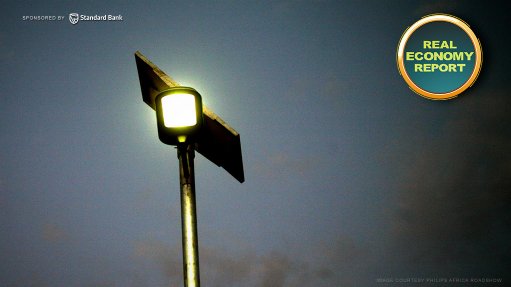
From Creamer Media in Johannesburg, this is the Real Economy Report. Royal Philips Electronics is continuing its programme of installing more than a hundred Community Light Centres across Africa with six new centres in South Africa. Joanne Taylor reports.
Joanne Taylor:
The 2013 Philips Cape Town to Cairo Roadshow is a vehicle for Philips to raise awareness on how healthcare and lighting solutions can enhance life in Africa. The roadshow will visit 18 cities in 17 African countries while Philips engages in a dialogue with customers, governments, non-profit organisations and media on the current power challenges in Africa.
The company has donated two Community Light Centres to the Department of Energy, which will be allocated to communities that will benefit from community lighting.
The light centres are areas of 1 000 m2, the size of a small soccer field, and are lit using a new generation of efficient solar powered light-emitting diode (LED) lighting. The centres create areas of light for rural communities that are without electricity.
Philips has committed €1.2-million over three years to the project for light centre that are focused on schools closely linked to rural areas and towns in off-grid or semi-grid areas to provide light for communal areas.
Philips Lighting Africa Senior Communications Manager Nick Kelso discusses the thinking behind the community light centres across Africa…
Philips Lighting Africa Senior Communications Manager Nick Kelso:
Well the LED lighting revolution presents Philips with two key opportunities to help with the power challenge in Africa. The first one is we can reduce energy – LEDs are extremely energy efficient and there are many other benefits but if they were installed across Africa at the current rate we would be able to save the equivalent of 35 power stations.
The second area that we can help with is the area that has no electricity, the 600-million Africans who live without electricity and without wide-scale lighting. When LEDs are combined with solar technology, we can now do extraordinary things. We can light large areas and we going to see an example of that tonight – a thousand square meters so you can start to think about communal activities in the evening.
We are using football to promote the site tonight but it can be used for healthcare, education, you can think about markets; it’s enabling life, it’s enabling social development and it is a really exciting development and this is the story we are going to tell on our road show to from Cape Town and all the way up to Cairo for the next four months.
Shannon de Ryhove:
Other news making headlines this week: Greenpeace Africa launches a 10 kWp rooftop solar system; Neotel moves to commercially launch LTE; and Government seeks private-sector assistance to deal with water infrastructure challenges.
Greenpeace Africa has started up a new 10 kWp rooftop solar photovoltaic panel installation at its Johannesburg office, which the organisation’s climate and energy campaigner Ruth Mhlanga says proves the feasibility of renewable energy in South Africa.
Greenpeace Africa climate and energy campaigner Ruth Mhlanga
Converged communications network operator Neotel is preparing to start launching commercial long-term evolution (or LTE) services by from July to September this year, with the technology initially being concentrated within the Gauteng region, serving customers through 50 LTE-enabled base stations.
Neotel MD and CEO Sunil Joshi
The Department of Water Affairs expects the private sector, non-governmental organisations, churches and other entities in South Africa to reduce the country’s water loss by half in 2014, by working with municipalities.
Department of Water and Environmental Affairs Deputy Minister Rejoice Mabudfhasi
That’s Creamer Media’s Real Economy Report. Join us again next week for more news and insight into South Africa’s real economy.